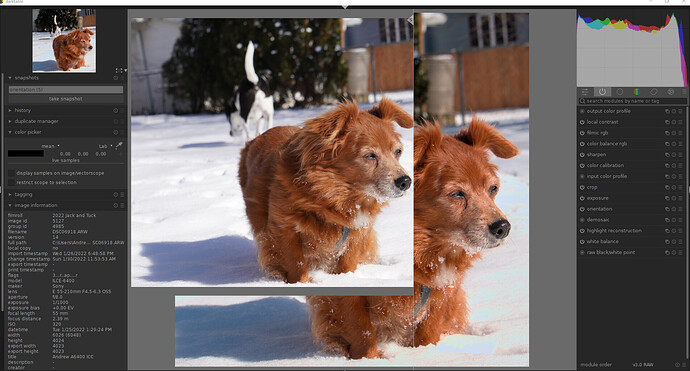Thanks to @priort, @age, @pass712, @dirksagwitz, @Jose_Figueres or providing samples. I think @pass712 is the winner.
Throwing my hat into the ring, I managed to get something not too crazy It ended up being kind of close to @pass712:
- Exposure: Change from 0.5 eV to 1 EV
- Tone Equalizer: Adjust mask and boosted the brown fur and green foliage
- Color Calibration: Change illuminant to as shot in camera
- Color balance RGB: add basic colurfulness preset and boosted the global vibrance and global chroma
- Local contrast: turn on
- Color zones: I couldn’t match his fur color without messing with the hue. He really does look like this IRL, so it’s disappointing to have to mess with it, even a little.
DSC06918 Andrew.xmp (14.9 KB)
My edit vs. the SOOC JPEG snapshot:
The goal of this topic was to spend less time doing corrective. I didn’t mess around with fimic RGB to see if I could get the same appearance without having to rely on the tone equalizer. Having to rely on color zones was disappointing. But could you make a style out of this edit so that it’s used on every import?
I’ve been reading up on some other topics and was able to make an ICC import profile for my camera. However, as I was typing this, I tested the import profile on several other images and realized parts of the snow and the background dog’s fur have a yellow / orange cast. I don’t think I have clipping. So this wasn’t completely successful, either.
- get the ISO 100 RAW with the x-rite color chart from Imaging-Resource
- Used adobe DNG converter
- Use x-rite ColorChecker Cameral Calibration to get its DCP
- Use dcp2icc to get the ICC.
- copy the ICC to
%appdata%\..\local\darktable\color\in. - Restart darktable.
After changing the import profile to the ICC, it now takes very little to come close to the SOOC JPG:
- Exposure: Change from 0.5 eV to 1 EV
- Color Balance RGB: add basic colorfulness
- Local contrast: turn on
I assume it’s pointless to share the XMP since you’d need my ICC to see it “correctly”. But here’s a screen shot to compare. His fur isn’t exactly the right hue and I’d like the gray whiskers on his face to stand out more, but it’s pretty darn close. But the orange snow / fur is wrong.
Any ideas why it’s turning some of my whites orange? Are there drawbacks to using a camera-specific ICC? I realize I didn’t have control of the shooting conditions of someone else’s sample and they’ve only licensed the image for personal use. Any technical flaws with the above conversion process?

